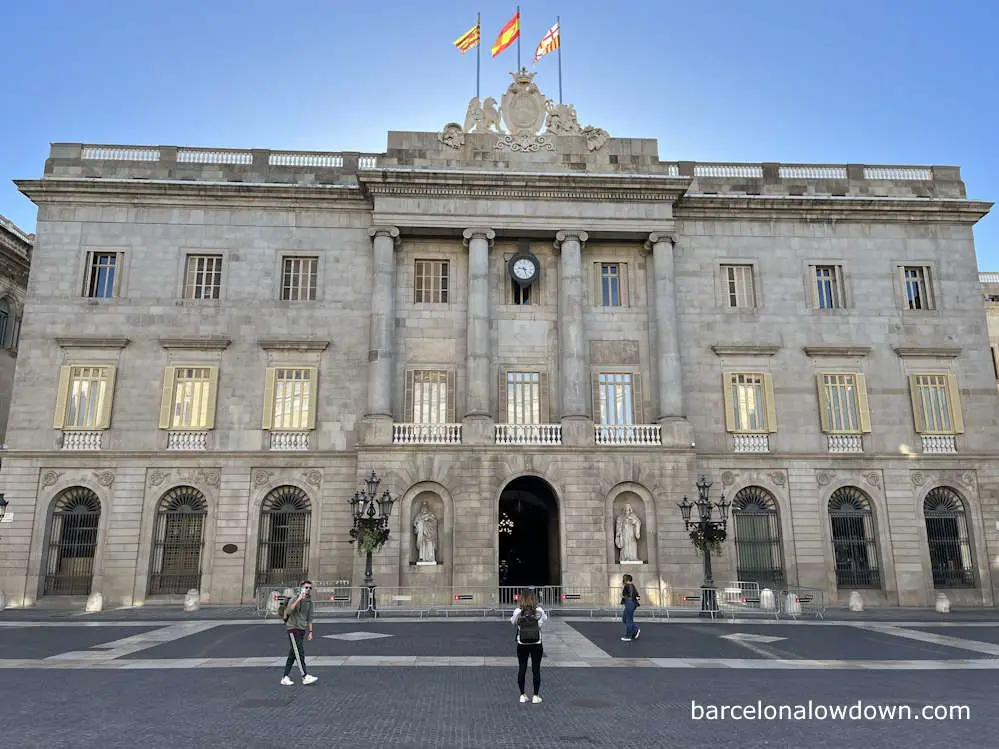Barcelona’s City Hall is an impressive example of Gothic architecture that has served as the local government’s headquarters since its construction in 1369.
Like many other buildings in Barcelona’s Gothic Quarter, the city hall has been subject to various modifications and additions. However, despite all the changes, parts of the interior have remained unchanged since the fourteenth century.
In this post, we will learn about the origins of Barcelona’s City Hall and explore the history of one of the city’s oldest institutions.

A Brief History of Barcelona’s City Hall
Barcelona’s city council dates back to 1249 when James I of Aragon appointed a group of advisors called the Concell de Cent to govern Barcelona and the surrounding area.
Initially, the Concell de Cent met on the steps of the Royal Palace in what is now Plaça del Rei. As the organisation grew, it began holding meetings in the convents of Santa Catalina and San Francisco before transferring to the current location at Plaça de Sant Jaume, once the site of the Roman Forum.
The City Hall building as we know it today dates back to 1369 when Pere Llobet was commissioned to design a building for council meetings. Since then, the building has been extended and modified several times, although parts of the original Gothic structure still remain, including the impressive Saló de Cent, which is still used for important ceremonial events.
The most visible change to the building took place in 1839 when the impressive Neoclassical main façade facing Plaça de Sant Jaume was added. The newest section of Barcelona City Hall, located at the rear of the building, was constructed in two phases between 1958 and 1978.

What to see in Barcelona’s City Hall
Whether you decide to take one of the free tours or visit on your own, the tour of Barcelona City Hall starts in the courtyard, which dates back to the fourteenth century and where there is a small collection of sculptures by famous Barcelona-born artists, including Joan Miró and Josep Llimona.
From here, you ascend the Staircase of Honour, which leads to the first floor and the Gothic Gallery. Above the staircase hang two large tapestries and a stone shield, which used to hang above one of the gateways of the defensive perimeter walls that surrounded Barcelona during the Middle Ages.

From the Gothic gallery, you can enjoy up-close views of the gargoyles, which date back to the sixteenth century and were originally installed on the exterior of the building to drain water from the roof.
Next, we come to El Saló de Cent, which is an impressive Gothic hall where the Concell de Cent held meetings dating back to the fourteenth century. It’s worth noting that the main entrance leading into the meeting room was originally part of an earlier building and was deliberately installed back-to-front so that the decorative reliefs, which were originally on the building’s exterior, can now be viewed from the inside.
From here, we enter the Saló Plenari Carles Pi i Sunyer, which was where Queen Maria Cristina held court during the Barcelona Universal Exposition of 1888. The circular grill, located at the centre of the room, is part of a novel heating system installed to keep the Queen warm during long speeches.

On the other side of El Saló de Cent is the Saló de les Cròniques, which is decorated with an impressive mural by Josep Maria Sert. The mural, which covers all four walls and the ceiling, recounts the history of Roger de Flor and the Almogàvers during their campaigns against the Ottoman Empire.
Sert employed a technique that involved painting over a layer of silver leaf to add a striking three-dimensional effect to the mural. If you focus on the tower, which is painted on the ceiling, you’ll notice how it appears to follow you as you move around the room.

Finally, we come to the Black Staircase, which is made entirely of black marble. Above the staircase is a mural depicting the Catalan people and famous landmarks such as Montserrat and the Isles Medes, based on a poem by Jacint Verdaguer.
As we descend the Black Staircase, we arrive at the courtyard and exit through the main doorway, leading us to Plaça de Sant Jaume.
Once outside, you can’t miss the impressive Neoclassical façade that was added to the building in 1839. You can also see the remains of the original Gothic façade, which is still visible from Carrer de la Ciutat.

Time needed to visit
You should allow approximately thirty minutes to visit the city hall or one hour if you will be taking one of the free guided tours.
Information in English
There are free leaflets available in English, Spanish, Catalan and French. There are also free tours, which are conducted in English, Spanish and Catalan (timetable below).

Location & how to get there
Barcelona city hall is located at Plaça de Sant Jaume, in the heart of the Gothic Quarter. The nearest metro stop is Jaume I on metro line L4 (the yellow line).
Address: Plaça de Sant Jaume, 1
When visiting the City Hall, you enter the building through the glass doors on Carrer de la font de Sant Miquel (see map below). After the visit, you leave the building through the main entrance, which opens directly onto Plaça de Sant Jaume.

Opening times
| Day | Opening hours |
| Sunday* | 10:00 – 13:00 |
Free guided tours
| Language | Schedule |
| English | 10:00 |
| Catalan | 10:30, 11:30, 12:30 |
| Spanish | 11:00, 12:00 |
The tour lasts approximately forty-five minutes, and you should arrive fifteen minutes before it is due to start so that you have time to clear security and register for the tour. There’s no need to book in advance.

Tickets
Free of charge, there’s no need to book in advance.
Other attractions nearby
- Plaça de Sant Jaume
- The Gothic Quarter
- Barcelona Cathedral
- El Pont del Bisbe (Bishop’s Bridge)
- Barcelona History Museum (MUHBA)
- Temple of Augustus (Roman Temple)
Map
Carrer de la Font de Sant Miquel




